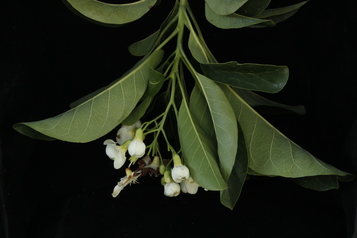guie' xuuba' Name used for two species of the Boraginaceae family. These are [...]
| Part of Speech | s |
| PDLMA | gye7 zhuuba |
| Speaker | {EJG,JLC,ND,VP,RLC04,FSL15,RLC15,VC15,VOT15} |
-
- Name used for two species of the Boraginaceae family. These are scarce trees that reach a height of 10 meters. They produce white flowers near the end of the dry season and a dark, lobed fruit shortly after the flowering period. There are considered to be two varieties: a wild variety (<B. purpusii>) and a cultivated variety (<B. huanita>). The flower is known for its pleasant aroma. Eustaquio Jiménez Girón states in his <Guía Gráfico-Fonémica para la Escritura y Lectura del Zapoteco> that the present-day name of this tree comes from the phrase <guie' xo' guiba'>, which the author translates as 'flower that exudes heavenly glory' or 'the mansion of the Gods'. In Tehuantepec, this flower is known as <guie' xo' ba'> which means 'tomb flower'.
- Se nombran así a dos especies de la familia Boraginaceae. Se trata de árboles escasos que alcanzan una altura de 10 metros. Su flor es blanca y se presenta hacia el final de la época de sequía. Su fruto es lobulado y oscuro y se presenta poco después del periodo de floración. Se conocen dos variedades, una de monte (<B. purpusii>) y una cultivada (<B. huanita>). La flor se aprecia particularmente por su aroma. Eustaquio Jiménez Girón indica en su <Guía Gráfico-Fonémica para la Escritura y Lectura del Zapoteco> que el nombre actual de este árbol proviene de la frase <guie' xo' guiba'> que el autor traduce como 'flor que perfuma la gloria celestial o mansión de los Dioses'. En Tehuantepec se conoce esta flor como <guie' xo'ba'> que se traduce como 'flor de tumbas'. [Spanish]
- Yagaguie'di' nabe rudiini baca'nda, naga'ni, risooni bia' chii metru. Yagadi' nadani ne huaxie'si tu nanna gudxiibani, laani randa ridaleni ne xcusini. Rinda' naxhi ca guie' quichi xtini, laacani riele'cani lu beeu abril ne beeu guie', ra'tacani lu bido'. Nuu chupa yagadi', tobini la guie'xhuuba lu guidxi ne xtobini la guie'xhuuba gui'xhi'. Ca xca ca yagadi' nachupaca' ne naga'ca' ne rixie'cani ora ruzulu riele' ca guie' xtini. Dxique ca rigola gudu'bacani, ruguuchacabe ca guie' bidxi xtini ne gueza, riguucabecani ndaani ti bacuela bidxi, ruza'cabe ti gueza gudxicabe laa: gueza nguaya. Ná ta Eustaquio Jiménez láni guie'xhuuba' la purti' zeedani de xho' guiba'. Nuu tu ná ruxhaleni diaga binni ora da'gu. [Diidxazá]
-
-
Example 66:
guie' xhuba gui'xhi la? ti yaga nasoo color cafeni la?, riaba xhabaladini ca pur parte la?, bandaga stìni ca la? nabata la? ne rácani yaga bacaanda' tamén, bacaandani la? ne guie' stìni ca la? ti guie' blancu naquichi', guie' quichi' ne nápani caadxi semiá huiini' stìni nayaase' ne rin... laaca rinda'naxhini ne qui riquiiñedini para, cuestión de para yaga lee la? para gástidi, mas que namuxeni para ndaani' yoo, riquiiñeni para xadesi ne pur guie' ca la? rinda'naxhini la?, pues no tiene otro usoths wild guie' xhuba is a tall tree, brown in call, its bark exfoliates by chunks, its leaves are wide, and it gives shade too, it provides shade, and its flowers are white, it has white flowers and it has small black seeds, it smells nice, it is not used to make fences, or anything, it is not sturdy for house construction, it can be used as firewood, and for its flowers, they smell nice, it has no other useel jazmín del Istmo es un árbol alto color café, se le cae la corteza por partes, su hoja es ancha y también es un árbol de sombra, es para sombra y su flor es una flor blanca y tiene unas semillas negras y también huele rico y no sirve para cuestiones de troncos de cerco, para nada, no es para uso rudo dentro de la casa, sólo sirve como leña para el fogón/ comal, huele rico, no tiene otro uso [Spanish]
-
Taxa <Bourreria huanita>;<Bourreria purpusii>;<Cordia>



















